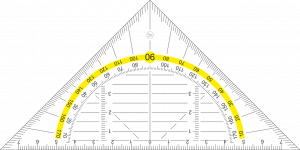Planning, Metrics, Risk & Reporting
 Let’s start with some definitions:
Let’s start with some definitions:
- Planning is the process of detailed proposal for doing or achieving something. Planning provides the basis of expectations that provides meaning to the metrics and risk analysis.
- Metrics are measurements of various activities. Metrics provide the transparency and visibility of activities.
- Risk is anything that keeps you from achieving your desired results. Risk analysis provides the early warning system.
- Reporting is the communication of data or information. Reporting provides the means of transmission for the information.
The diagram here provides a normal planning cycle. It provides a natural feedback loop where adjustments are constantly being made based on the changing environment. Based on the planning, metrics are identified and a means of collecting the information is implemented. Upon review of the metrics, the status of some risks may need to be updated. The metrics and risks are reported at the proper levels. Planning is adjusted accordingly.
Planning
 A discussion on various types of planning are provided in another section. However, while the approach to planning may vary by the type needed, various outputs need to be produced. These include:
A discussion on various types of planning are provided in another section. However, while the approach to planning may vary by the type needed, various outputs need to be produced. These include:
- Metrics – What is important to capture. Each level of planning should be resulting in some objective. What is that objective? How do we measure the results? How do we know if we are successful? Maybe the metric is where we are in the schedule for a project? Maybe a metric is the production volume that we are expecting to achieve? Quality control objectives?
- Risk Elements – As will be discussed in the Risk topic, assessing risk is a continuing process. But in the planning process, there should be an assessment as to the potential obstacles that may prevent the timely, cost effective completion of your goals. These need to be tracked and regularly assessed.
- Reporting – Who neeeds to know what when? The operations or project manager should be aware of daily events. How do they know? Moving up the line, various managers need to know when issues are developing? Who determines who and when? Are there policies needed that dictate certain actions need to be reported? Remember, it is more advantages for an issue to be addressed before it is a problem. Intervention prior to the a full blown blow up is usually cheaper to resolve.
All of these areas need to be addressed as planning begins and as planning is modified. Planning is a dynamic process. It is part of the feedback loop. Environments are constantly changing. Unplanned events are constantly occurring. People get sick, component deliveries are not made. New laws occur. Activities take longer than expected. Adjustments need to be made and it is important to be able to identify and assess issues quickly to minimize impacts.
Additional discussion on types of planning can be found at Planning Types.
(Image by Pexels from Pixabay)
Return to Top
Metrics
 One of the hardest tasks in planning is identifying metrics. Metrics are measurements that quantify a characteristic. This could be a count. It could be a count. It could be a measure of progress. There is an argument that goals should be SMART. That means they should be:
One of the hardest tasks in planning is identifying metrics. Metrics are measurements that quantify a characteristic. This could be a count. It could be a count. It could be a measure of progress. There is an argument that goals should be SMART. That means they should be:
- Specific – well-defined, precise
- Measurable – some measure that provides insight into its success. And you should remember that we want to be able to measure a progress, not just a pass or fail. If we cannot measure progress, we do not know if we are approaching trouble.
- Attainable – you have to actually be able to accomplish the goal.
- Relevant – should align with a value you are trying to achieve in the endeavor.
- Time-Based – you want it by a certain time. If anytime will do, then you really do not need it.
Risk
 A risk is anything that may prevent you from achieving your goal. It is your early warning system. We mention this again because the sooner a risk is identified, the sooner it can be addressed. All risks should be tracked, even if just by a spreadsheet. You should know when it was identified, who is responsible for managing its resolution, a history of the activity on the item and resolution, whenever that occurs.
A risk is anything that may prevent you from achieving your goal. It is your early warning system. We mention this again because the sooner a risk is identified, the sooner it can be addressed. All risks should be tracked, even if just by a spreadsheet. You should know when it was identified, who is responsible for managing its resolution, a history of the activity on the item and resolution, whenever that occurs.
All team members and management are responsible for identifying risks and monitoring them. Awareness by everyone enables everyone to potentially identify and provide a solution. However, since no one can do all things, there will be an obvious partitioning of responsibility and reporting that provides manageability. Various risks will be monitored by the team. If their possibility of occurrence rises or impact to the project becomes worse, they may need to be promoted to the next level.
As time progresses, some risks will get resolved. Other risks will develop. As a result, there should be a regular review of existing risks and possibly new risks that are developing.
In Agile, part of Risk Management is to ROAM your risk. That means you place your risk in one of the categories:
- Resolved – a solution to the risk has been identified and will be implemented. The risk no longer exists.
- Owned – there is an unresolved risk and a person has been identified to work the resolution. And that person will report on it.
- Accepted – the risk has been accepted if it occurs. No meaningful resolution is available and you will need to live with the results.
- Mitigated – alternatives have been identified that will reduce the impact of its occurrence.
Proper risk management is always going to include looking for options in case the risk becomes a problem. The sooner the alternatives can be identified, the sooner the alternative can be weaved into the planning.
(Image by Lothar Dieterich from Pixabay )
Return to Top
Reporting
 Reporting is your communication function. It provides the statuses and enables teams and management to know where they stand. Production or project status tells each group where they stand and tells management who needs attention. It should be remembered that getting attention is not supposed to be bad. Changes in environments, failures of components, impacts of personnel losses can all have critical impacts. And even if the local management and teams are handling it, it is important that management is aware and they are ensuring the support needed to overcome the challenges.
Reporting is your communication function. It provides the statuses and enables teams and management to know where they stand. Production or project status tells each group where they stand and tells management who needs attention. It should be remembered that getting attention is not supposed to be bad. Changes in environments, failures of components, impacts of personnel losses can all have critical impacts. And even if the local management and teams are handling it, it is important that management is aware and they are ensuring the support needed to overcome the challenges.
Effective reporting has some important characteristics:
- Addresses the needs of the level of management reviewing it – Upper management has many more operations to manage, so their reporting does not need to address the intricacies of reports for lower management. However, it does need to see the general health of the individual operations and see the risks that may have the greatest impacts.
- Compact – Think dashboards. Teams and management have many things to accomplish on any day. Reports should be easily interpreted. And when possible, dashboards that provides good, neutral and negative signals allow attention to be focused quickly on problem areas.
- Timely – Reports need to occur in timeframes that are functional. This could be hourly, daily, weekly, monthly, quarterly, annually. The timeframe needs to be fresh enough for the report to be meaningful and actionable. Related to the latter, sometimes reporting on particular elements may need to be temporarily accelerated when a problem has arisen until the issue has been resolved.
- Accurate – One would think this would go without saying, but if the report does not provide accurate information, it is unactionable.
